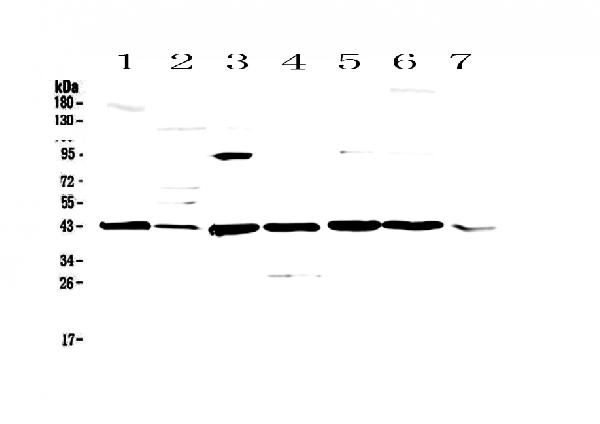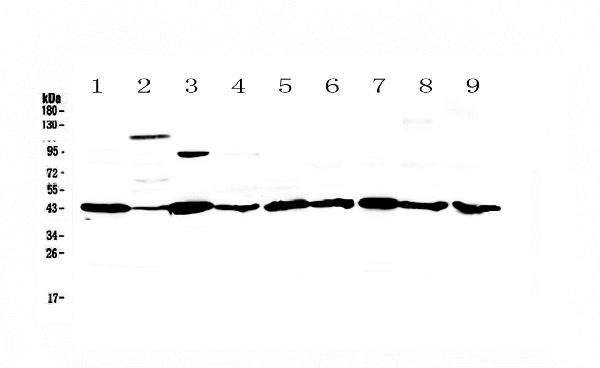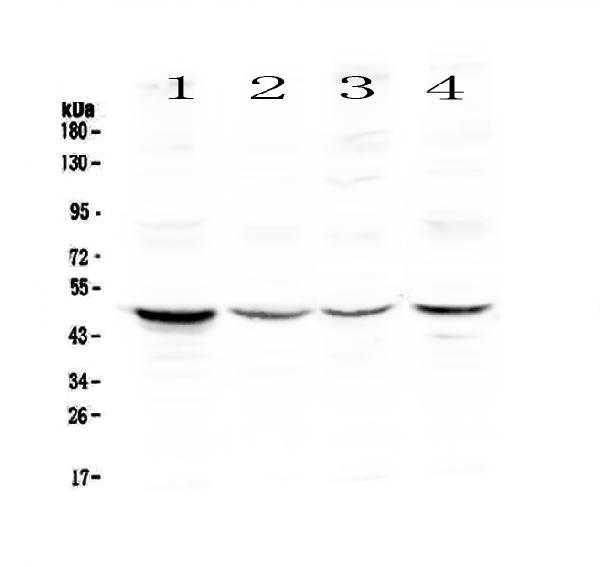Product Info Summary
| SKU: | A02941-2 |
|---|---|
| Size: | 100 μg/vial |
| Reactive Species: | Human, Mouse, Rat |
| Host: | Rabbit |
| Application: | ELISA, IF, ICC, WB |
Customers Who Bought This Also Bought
Product info
Product Name
Anti-Caspase 4/Casp4 Antibody Picoband®
SKU/Catalog Number
A02941-2
Size
100 μg/vial
Form
Lyophilized
Description
Boster Bio Anti-Caspase 4/Casp4 Antibody Picoband® catalog # A02941-2. Tested in ELISA, IF, ICC, WB applications. This antibody reacts with Human, Mouse, Rat. The brand Picoband indicates this is a premium antibody that guarantees superior quality, high affinity, and strong signals with minimal background in Western blot applications. Only our best-performing antibodies are designated as Picoband, ensuring unmatched performance.
Storage & Handling
Store at -20˚C for one year from date of receipt. After reconstitution, at 4˚C for one month. It can also be aliquotted and stored frozen at -20˚C for six months. Avoid repeated freeze-thaw cycles.
Cite This Product
Anti-Caspase 4/Casp4 Antibody Picoband® (Boster Biological Technology, Pleasanton CA, USA, Catalog # A02941-2)
Host
Rabbit
Contents
Each vial contains 4mg Trehalose, 0.9mg NaCl, 0.2mg Na2HPO4, 0.05mg NaN3.
Clonality
Polyclonal
Isotype
Rabbit IgG
Immunogen
E. coli-derived mouse Caspase 4 recombinant protein (Position: E108-T195).
*Blocking peptide can be purchased. Costs vary based on immunogen length. Contact us for pricing.
Cross-reactivity
No cross-reactivity with other proteins.
Reactive Species
A02941-2 is reactive to Casp4 in Human, Mouse, Rat
Reconstitution
Add 0.2ml of distilled water will yield a concentration of 500ug/ml.
Observed Molecular Weight
43 kDa
Calculated molecular weight
79686 MW
Background of CASP4
Caspase 4 is an enzyme that proteolytically cleaves other proteins at an aspartic acid residue, and belongs to a family of cysteine proteases called caspases. The Caspase 4 gene is mapped to a P1 clone containing the ICE gene, which is located at chromosome 11q22.2-q22.3. It contains 8 coding exons. The function of caspase 4 is not fully known, but it is believed to be an inflammatory caspase, along with caspase 1, caspase 5 (and the murine homolog caspase 11), with a role in the immune system.
Antibody Validation
Boster validates all antibodies on WB, IHC, ICC, Immunofluorescence, and ELISA with known positive control and negative samples to ensure specificity and high affinity, including thorough antibody incubations.
Application & Images
Applications
A02941-2 is guaranteed for ELISA, IF, ICC, WB Boster Guarantee
Assay Dilutions Recommendation
The recommendations below provide a starting point for assay optimization. The actual working concentration varies and should be decided by the user.
Western blot, 0.1-0.5μg/ml
Immunocytochemistry/Immunofluorescence, 5μg/ml
ELISA, 0.1-0.5μg/ml
Positive Control
WB: mouse liver tissue, mouse testis tissue, mouse thymus tissue, mouse lung tissue, mouse HEPA1-6 whole cell, mouse NIH3T3 whole cell, mouse SP20 whole cell, rat liver tissue, rat testis tissue, rat stomach tissue, rat thymus tissue, human COLO-320 whole cell, human HepG2 whole cell, human 22RV1 whole cell, human PANC-1 whole cell, human SGC-7901 whole cell
ICC/IF: A431 cell
FCM: A431 cell
Validation Images & Assay Conditions

Click image to see more details
Figure 1. Western blot analysis of Caspase 4 using anti-Caspase 4 antibody (A02941-2).
Electrophoresis was performed on a 5-20% SDS-PAGE gel at 70V (Stacking gel) / 90V (Resolving gel) for 2-3 hours. The sample well of each lane was loaded with 50ug of sample under reducing conditions.
Lane 1: mouse liver tissue lysates,
Lane 2: mouse testis tissue lysates,
Lane 3: mouse thymus tissue lysates,
Lane 4: mouse lung tissue lysates,
Lane 5: mouse HEPA1-6 whole cell lysates,
Lane 6: mouse NIH3T3 whole cell lysates,
Lane 7: mouse SP20 whole cell lysates.
After Electrophoresis, proteins were transferred to a Nitrocellulose membrane at 150mA for 50-90 minutes. Blocked the membrane with 5% Non-fat Milk/ TBS for 1.5 hour at RT. The membrane was incubated with rabbit anti-Caspase 4 antigen affinity purified polyclonal antibody (Catalog # A02941-2) at 0.5 μg/mL overnight at 4°C, then washed with TBS-0.1%Tween 3 times with 5 minutes each and probed with a goat anti-rabbit IgG-HRP secondary antibody at a dilution of 1:10000 for 1.5 hour at RT. The signal is developed using an Enhanced Chemiluminescent detection (ECL) kit (Catalog # EK1002) with Tanon 5200 system. A specific band was detected for Caspase 4 at approximately 43KD. The expected band size for Caspase 4 is at 43KD.

Click image to see more details
Figure 2. Western blot analysis of Caspase 4 using anti-Caspase 4 antibody (A02941-2).
Electrophoresis was performed on a 5-20% SDS-PAGE gel at 70V (Stacking gel) / 90V (Resolving gel) for 2-3 hours. The sample well of each lane was loaded with 50ug of sample under reducing conditions.
Lane 1: rat liver tissue lysates,
Lane 2: rat testis tissue lysates,
Lane 3: rat stomach tissue lysates,
Lane 4: rat thymus tissue lysates,
Lane 5: human COLO-320 whole cell lysates,
Lane 6: human HepG2 whole cell lysates,
Lane 7: human 22RV1 whole cell lysates,
Lane 8: human PANC-1 whole cell lysates,
Lane 9: human SGC-7901 whole cell lysates.
After Electrophoresis, proteins were transferred to a Nitrocellulose membrane at 150mA for 50-90 minutes. Blocked the membrane with 5% Non-fat Milk/ TBS for 1.5 hour at RT. The membrane was incubated with rabbit anti-Caspase 4 antigen affinity purified polyclonal antibody (Catalog # A02941-2) at 0.5 μg/mL overnight at 4°C, then washed with TBS-0.1%Tween 3 times with 5 minutes each and probed with a goat anti-rabbit IgG-HRP secondary antibody at a dilution of 1:10000 for 1.5 hour at RT. The signal is developed using an Enhanced Chemiluminescent detection (ECL) kit (Catalog # EK1002) with Tanon 5200 system. A specific band was detected for Caspase 4 at approximately 43KD. The expected band size for Caspase 4 is at 43KD.

Click image to see more details
Figure 3. IF analysis of Caspase 4 using anti-Caspase 4 antibody (A02941-2).
Caspase 4 was detected in immunocytochemical section of A431 cell. Enzyme antigen retrieval was performed using IHC enzyme antigen retrieval reagent (AR0022) for 15 mins. The cells were blocked with 10% goat serum. And then incubated with 2μg/mL rabbit anti-Caspase 4 Antibody (A02941-2) overnight at 4°C. DyLight®488 Conjugated Goat Anti-Rabbit IgG (BA1127) was used as secondary antibody at 1:100 dilution and incubated for 30 minutes at 37°C. The section was counterstained with DAPI. Visualize using a fluorescence microscope and filter sets appropriate for the label used.

Click image to see more details
Figure 4. Flow Cytometry analysis of A431 cells using anti-Caspase 4 antibody (A02941-2).
Overlay histogram showing A431 cells stained with A02941-2 (Blue line).The cells were blocked with 10% normal goat serum. And then incubated with rabbit anti-Caspase 4 Antibody (A02941-2,1μg/1x106 cells) for 30 min at 20°C. DyLight®488 conjugated goat anti-rabbit IgG (BA1127, 5-10μg/1x106 cells) was used as secondary antibody for 30 minutes at 20°C. Isotype control antibody (Green line) was rabbit IgG (1μg/1x106) used under the same conditions. Unlabelled sample (Red line) was also used as a control.
Protein Target Info & Infographic
Gene/Protein Information For Casp4 (Source: Uniprot.org, NCBI)
Gene Name
Casp4
Full Name
Caspase-4
Weight
79686 MW
Superfamily
peptidase C14A family
Alternative Names
Caspase-4; CASP-4 CASP4 ICE(rel)II, ICEREL-II, ICH-2, Mih1, Mih1/TX, TX caspase 4 caspase-4|CASP-4|ICE and Ced-3 homolog 2|ICE(rel)-II|apoptotic cysteine protease Mih1/TX|caspase 4, apoptosis-related cysteine peptidase|caspase 4, apoptosis-related cysteine protease|caspase-4 isoform alpha|protease ICH-2|protease TX
*If product is indicated to react with multiple species, protein info is based on the gene entry specified above in "Species".For more info on Casp4, check out the Casp4 Infographic

We have 30,000+ of these available, one for each gene! Check them out.
In this infographic, you will see the following information for Casp4: database IDs, superfamily, protein function, synonyms, molecular weight, chromosomal locations, tissues of expression, subcellular locations, post-translational modifications, and related diseases, research areas & pathways. If you want to see more information included, or would like to contribute to it and be acknowledged, please contact [email protected].
Specific Publications For Anti-Caspase 4/Casp4 Antibody Picoband® (A02941-2)
Hello CJ!
A02941-2 has been cited in 1 publications:
*The publications in this section are manually curated by our staff scientists. They may differ from Bioz's machine gathered results. Both are accurate. If you find a publication citing this product but is missing from this list, please let us know we will issue you a thank-you coupon.
Chen J, Wei H, Xie B, Wang B, Cheng J, Cheng J. Leuk Res. 2012 Dec;36(12):1526-35. Doi: 10.1016/J.Leukres.2012.08.018. Epub 2012 Sep 7. Endoplasmic Reticulum Stress Contributes To Arsenic Trioxide-Induced Apoptosis In Drug-Sensitive And -Resistant...
Recommended Resources
Here are featured tools and databases that you might find useful.
- Boster's Pathways Library
- Protein Databases
- Bioscience Research Protocol Resources
- Data Processing & Analysis Software
- Photo Editing Software
- Scientific Literature Resources
- Research Paper Management Tools
- Molecular Biology Software
- Primer Design Tools
- Bioinformatics Tools
- Phylogenetic Tree Analysis
Customer Reviews
Have you used Anti-Caspase 4/Casp4 Antibody Picoband®?
Submit a review and receive an Amazon gift card.
- $30 for a review with an image
0 Reviews For Anti-Caspase 4/Casp4 Antibody Picoband®
Customer Q&As
Have a question?
Find answers in Q&As, reviews.
Can't find your answer?
Submit your question
4 Customer Q&As for Anti-Caspase 4/Casp4 Antibody Picoband®
Question
Does A02941-2 anti-Caspase 4/Casp4 antibody work on parafin embedded sections? If so, which fixation method do you recommend we use (PFA, paraformaldehyde, other)?
Verified Customer
Verified customer
Asked: 2019-08-02
Answer
As indicated on the product datasheet, A02941-2 anti-Caspase 4/Casp4 antibody as been tested on WB. It is best to use PFA for fixation because it has better tissue penetration ability. PFA needs to be prepared fresh before use. Long term stored PFA turns into formalin, as the PFA molecules congregate and become formalin.
Boster Scientific Support
Answered: 2019-08-02
Question
Do you have a BSA free version of anti-Caspase 4/Casp4 antibody A02941-2 available?
R. Carter
Verified customer
Asked: 2017-04-26
Answer
We appreciate your recent telephone inquiry. I can confirm that some lots of this anti-Caspase 4/Casp4 antibody A02941-2 are BSA free. For now, these lots are available and we can make a BSA free formula for you free of charge. It will take 3 extra days to prepare. If you require this antibody BSA free again in future, please do not hesitate to contact me and I will be pleased to check which lots we have in stock that are BSA free.
Boster Scientific Support
Answered: 2017-04-26
Question
Would anti-Caspase 4/Casp4 antibody A02941-2 work for WB with uterus?
C. Lewis
Verified customer
Asked: 2016-01-26
Answer
According to the expression profile of uterus, CASP4 is highly expressed in uterus. So, it is likely that anti-Caspase 4/Casp4 antibody A02941-2 will work for WB with uterus.
Boster Scientific Support
Answered: 2016-01-26
Question
I am interested in to test anti-Caspase 4/Casp4 antibody A02941-2 on mouse uterus for research purposes, then I may be interested in using anti-Caspase 4/Casp4 antibody A02941-2 for diagnostic purposes as well. Is the antibody suitable for diagnostic purposes?
M. Edwards
Verified customer
Asked: 2015-06-18
Answer
The products we sell, including anti-Caspase 4/Casp4 antibody A02941-2, are only intended for research use. They would not be suitable for use in diagnostic work. If you have the means to develop a product into diagnostic use, and are interested in collaborating with us and develop our product into an IVD product, please contact us for more discussions.
Boster Scientific Support
Answered: 2015-06-18





